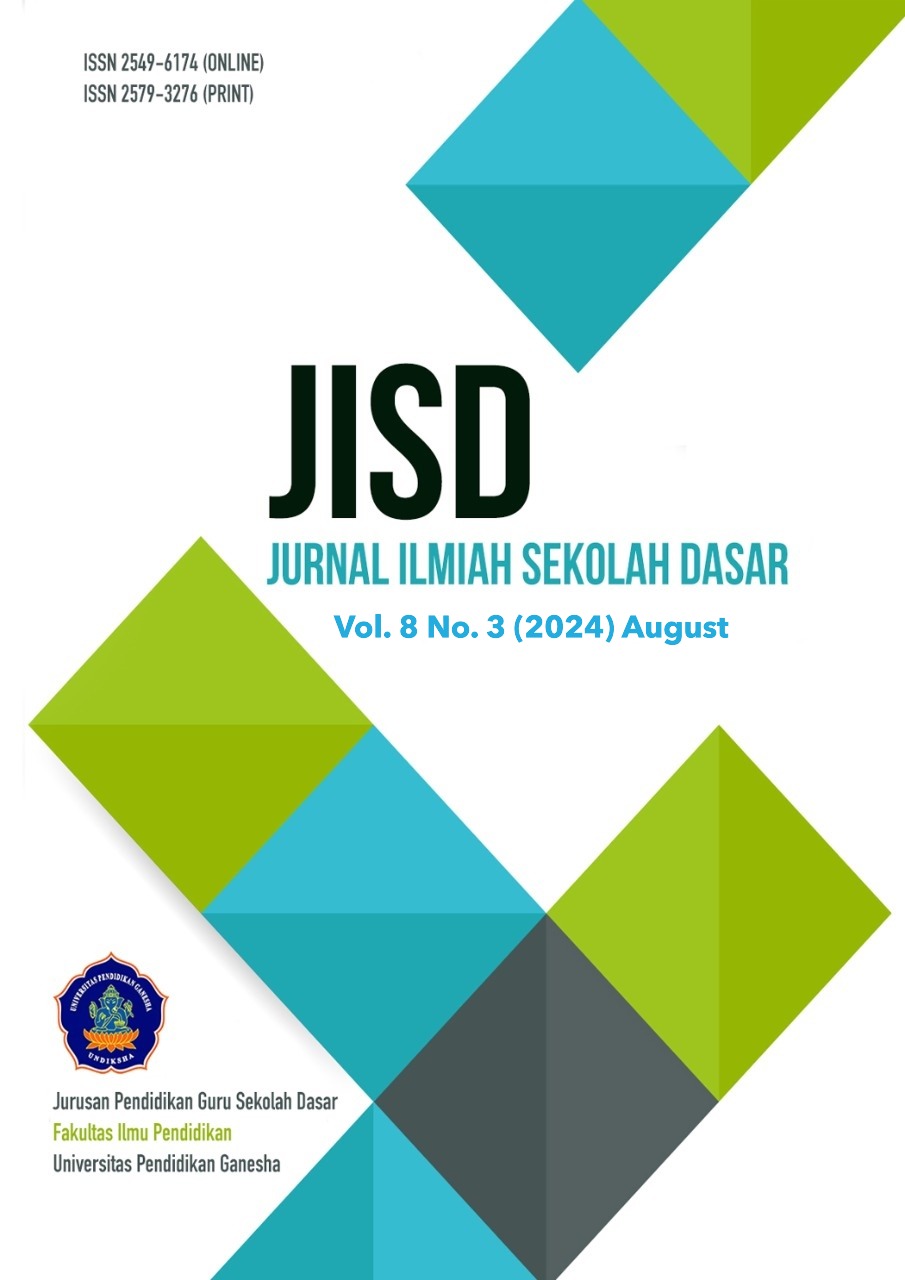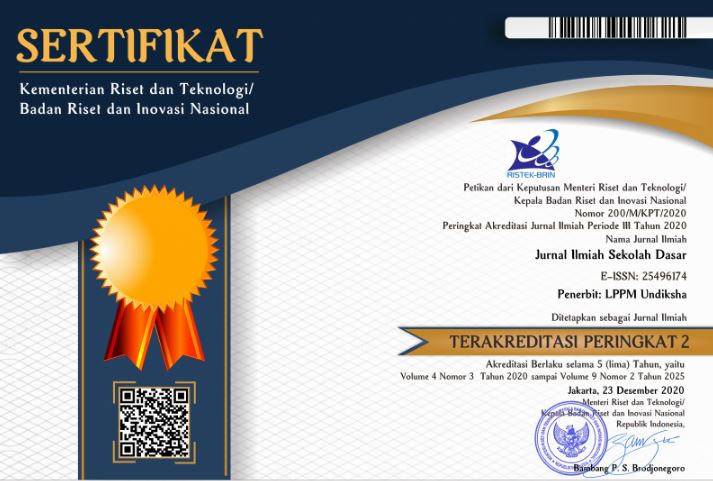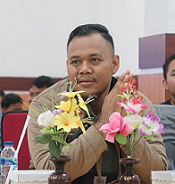The Effect of Problem Based Learning Models and Auditory Learning Styles on Internship Learning Outcomes in Elementary Schools
DOI:
https://doi.org/10.23887/jisd.v8i3.68940Keywords:
Problem Based Learning, Auditorial Learning Style, Learning OutcomesAbstract
Education in Indonesia faces the challenge of improving student learning outcomes through appropriate learning models and effective content delivery. This study aims to analyze the influence of Problem-Based Learning (PBL) and auditory learning styles on the critical thinking skills of elementary school students. The study employed a quantitative approach using a pre-experimental (non-design) method. Data were collected through multiple-choice tests to assess learning outcomes and questionnaires to identify students' auditory learning preferences. The sample consisted of 28 fifth-grade students. The findings revealed a significant impact of the PBL model on students with auditory learning styles in enhancing critical thinking skills. Hypothesis testing showed a probability value of 0.000 > α = 0.05, indicating a significant relationship between the learning model and student outcomes. The integration of PBL tailored to students' learning styles can effectively improve their conceptual understanding and critical thinking skills. The study concludes that implementing a problem-based learning model combined with an auditory learning style positively influences students' learning outcomes in civic education, particularly in developing critical thinking abilities in elementary school students.
References
Adifta, E. D., Murni, A., & Roza, Y. (2022). Desain Perangkat Pembelajaran Daring Menggunakna Model Problem Based Learning dengan Pendekatan STEAM pada Materi Barisan dan Deret. PRISMA (Prosiding Seminar Nasional Matematika), 98–105.
https://journal.unnes.ac.id/sju/index.php/prisma/article/view/54346.
Adom, D., Mensah, J. A., & Dake, D. A. (2020). Test, Measurement, and Evaluation: Understanding and Use of the Concepts in Education. International Journal of Evaluation and Research in Education, 9(1), 109–119. https://doi.org/10.11591/ijere.v9i1.20457.
Amin, E. a. (2016). Perbedaan Prestasi Belajar Matematika Siswa Ditinjau Dari Gaya Belajar Dan Model Pembelajaran. Jurnal Prima Edukasia, 4(1), 12. https://doi.org/10.21831/jpe.v4i1.7688.
As’ari, A. R., & Kurniati, et. al. (2019). Impact of infusing truth-seeking and open-minded behaviors on mathematical problem-solving. Journal for the Education of Gifted Young Scientists, 7(4), 1019–1036. https://doi.org/10.17478/jegys.606031.
Asrifah, S., Solihatin, E., Arif, A., Rusmono, & Iasha, V. (2020). Pengaruh Model Pembelajaran Problem Based Learning Terhadap Hasil Belajar Pendidikan Pancasila Dan Kewarganegaraan Siswa Kelas V Sdn Pondok Pinang 05. Buana Pendidikan: Jurnal Fakultas Keguruan Dan Ilmu Pendidikan, 16(30), 183–193. https://doi.org/10.36456/bp.vol16.no30.a2719.
Astiti, N. D., Mahadewi, L. P. P., & Suarjana, I. M. (2021). Faktor Yang Mempengaruhi Hasil Belajar IPA. JUrnal Mimbar Ilmu, 26(2), 193–203. https://doi.org/10.23887/mi.v26i2.35688.
Azzahrah Putri, R., Magdalena, I., Fauziah, A., & Nur Azizah, F. (2021). Pengaruh Gaya Belajar terhadap Pembelajaran Siswa Sekolah Dasar. Cerdika: Jurnal Ilmiah Indonesia, 1(2), 157–163. https://doi.org/10.59141/cerdika.v1i2.26.
Barrows, H. S. (2000). Problem-based learning applied to medical education. Southern Illinois University School of Medicine.
Bell, S. (2010). Project-Based Learning for the 21st Century: Skills for the Future. The Clearing House: A Journal of Educational Strategies, Issues and Ideas, 83(2), 39–43.
https://doi.org/10.1080/00098650903505415.
Bojko, A. (2013). Eye Tracking The User Experience. Rosenfeld Media.
Chueh, H.-E., & Kao, C.-Y. (2024). Exploring the impact of integrating problem based learning and agile in the classroom on enhancing professional competence. Heliyon, 10(3), e24887. https://doi.org/10.1016/j.heliyon.2024.e24887.
Creswell, J. W. (2018). Creswell_Research_Design_ Qualitative, Quantitative, and Mixed Methods Approaches. In Sage Publications Inc.
Daryanes, F., Darmadi, D., Fikri, K., Sayuti, I., Rusandi, M. A., & Situmorang, D. D. B. (2023). The Development of Articulate Storyline Interactive Learning Media Based on Case Methods to Train Students Problem-Solving Ability. Heliyon, 9(4). https://doi.org/10.1016/j.heliyon.2023.e15082.
Dewi, K. M. C., Suryati, N. W. N., & Rusanti, P. (2023). Gaya Belajar Mahasiswa Program Studi D-IV Keperawatan Anestesiologi di Institut Teknologi dan Kesehatan Bali. Jurnal Basicedu, 7(5), 3148–3157. https://doi.org/10.31004/basicedu.v7i5.6305.
Ekowati, C. K., Madu, A., Nenohai, J. M., & Wangge, M. (2022). The influence of environment and mathematical learning styles on students’ GPA through independent learning as an intervening variable. Jurnal Riset Pendidikan Matematika, 9(2), 162–176.
https://doi.org/10.21831/jrpm.v9i2.49667.
Ezzeddine, N., Hughes, J., Kaulback, S., Houk, S., Mikhael, J., & Vickery, A. (2023). Implications of understanding the undergraduate nursing students’ learning styles: A discussion paper. Journal of Professional Nursing, 49(September), 95–101. https://doi.org/10.1016/j.profnurs.2023.09.006.
Ganiwati, W. S. (2022). Pembelajaran Discovery Learning Meningkatkan Aktivitas Dan Hasil Belajar Secara Daring Pokok Bahasan Laporan Hasil Observasi Siswa Kelas X IPA 2 SMA Negeri 1 Tajurhalang. Action : Jurnal Inovasi Penelitian Tindakan Kelas Dan Sekolah, 2(4), 433–443.
https://doi.org/10.51878/action.v2i4.1761.
Hafizha, D., Ananda, R., & Aprinawati, I. (2022). Analisis Pemahaman Guru Terhadap Gaya Belajar Siswa Di Sdn 020 Ridan Permai. Jurnal Review Pendidikan Dasar : Jurnal Kajian Pendidikan Dan Hasil Penelitian, 8(1), 25–33. https://doi.org/10.26740/jrpd.v8n1.p25-33.
Han, D., & Qian, D. D. (2024). Evaluating the roles of breadth and depth of aural vocabulary knowledge in listening comprehension of EFL learners: An investigation applying auditory measures. System, 120, 103207. https://doi.org/10.1016/j.system.2023.103207.
Harie, S. (2016). Pengaruh Metode Pembelajaran dan Gaya Belajar terhadap Kemampuan Berpikir Kritik Biologi. Formatif: Jurnal Ilmiah Pendidikan MIPA, 5(3). https://doi.org/10.30998/formatif.v5i3.651.
Hikmah, S. N. (2021). Implementasi nilai pendidikan karakter melalui pendidikan kewarganegaraan di perguruan tinggi. Jurnal Penelitian Humaniora, 26(2), 53–59.
https://www.academia.edu/download/86187310/pdf.pdf.
Hmelo-Silver, C. E., Duncan, R. G., & CHINN, C. A. (2007). Scaffolding and Achievement in Problem-Based and Inquiry Learning: A Response to Kirschner, Sweller, and Clark (2006). Educational Psychologist, 42(2), 99–107. https://doi.org/10.1080/00461520701263368.
Hwang, et. al. (2024). Learning to teach through problem posing: A teacher’s journey in a networked teacher−researcher partnership. The Journal of Mathematical Behavior, 73, 101120. https://doi.org/10.1016/j.jmathb.2023.101120.
Inastuti, I. G. A. S., Subarinah, S., Kurniawan, E., & Amrullah, A. (2021). Analisis Kemampuan Pemecahan Masalah Pola Bilangan Ditinjau Dari Gaya Belajar. Griya Journal of Mathematics Education and Application, 1(1), 66–80. https://doi.org/10.29303/griya.v1i1.4.
Indahri, Y. (2021). Asesmen Nasional sebagai Pilihan Evaluasi Sistem Pendidikan Nasional. Aspirasi: Jurnal Masalah-Masalah Sosial, 12(2). https://doi.org/10.46807/aspirasi.v12i2.2364.
Karlina, F., Asyhar, R., & Asrial, A. (2014). Pengaruh Model PBL Bermedia Muatan Lokal dan Gaya Belajar terhadap Hasil Belajar Siswa pada Materi Klasifikasi Zat di Kelas VII SMP. Edu-Sains: Jurnal Pendidikan Matematika Dan Ilmu Pengetahuan Alam, 3(2).
https://doi.org/10.22437/jmpmipa.v3i2.1889.
Kirschner, P. A., Sweller, J., & Clark, R. E. (2006). Why minimal guidance during instruction does not work: An analysis of the failure of constructivist, discovery, problem-based, experiential, and inquiry-based teaching. Educational Psychologist, 41(2), 75–86.
https://doi.org/10.1207/s15326985ep4102_1.
Kusumawati, N. M. (2017). Optimalisasi Model Pembelajaran Berbasis Masalah Dengan Berbantuan Lembar Kerja Siswa (Lks) Untuk Meningkatkan Aktivitas Dan Hasil Belajar Dalam Mata Pelajaran Matematika. Journal of Education Action Research, 1(3), 197.
https://doi.org/10.23887/jear.v1i3.12684.
Lee, H., & Boo, E. (2022). The effects of teachers’ instructional styles on students’ interest in learning school subjects and academic achievement: Differences according to students’ gender and prior interest. Learning and Individual Differences, 99, 7. https://doi.org/10.1016/j.lindif.2022.102200.
Lestari, D. D., Ansori, I., & Karyadi, B. (2017). Penerapan Model Pbm Untuk Meningkatkan Kinerja Dan Kemampuan Berpikir Kritis Siswa Sma. Diklabio: Jurnal Pendidikan Dan Pembelajaran Biologi, 1(1), 45–53. https://doi.org/10.33369/diklabio.1.1.45-53.
Mahalingappa, L., Zong, J., & Polat, N. (2024). The impact of captioning and playback speed on listening comprehension of multilingual English learners at varying proficiency levels. System, 120, 103192. https://doi.org/10.1016/j.system.2023.103192.
Maretasani, L. D. (2018). Penerapan Problem Based Learning (PBL) Terhadap Kemampuan Pemecahan Masalah Matematis Siswa. Widya Warta, XLII(2), 173–184.
Marpaung, J. (2016). Pengaruh Gaya Belajar Terhadap Prestasi Belajar Siswa. KOPASTA: Jurnal Program Studi Bimbingan Konseling, 2(2). https://doi.org/10.33373/kop.v2i2.302.
Masjaya, & Wardono. (2018). Pentingnya Kemampuan Literasi Matematika untuk Menumbuhkan Kemampuan Koneksi Matematika dalam Meningkatkan SDM. PRISMA (Prosiding Seminar Nasional Matematika), 568–574. https://journal.unnes.ac.id/sju/index.php/prisma/article/view/20196.
Minasari, U., & Susanti, R. (2023). Penerapan Model Problem Based Leaning Berbasis Berdiferensiasi berdasarakan Gaya Belajar Peserta Didik pada Pelajaran Biologi. Ideguru: Jurnal Karya Ilmiah Guru, 8(2), 282–287. https://doi.org/10.51169/ideguru.v8i2.543.
Monica, H., Kesumawati, N., & Septiati, E. (2019). Pengaruh Model Problem Based Learning Terhadap Kemampuan Pemecahan Masalah Matematis dan Keyakinan Matematis Siswa. MaPan (Jurnal Matematika Dan Pembelajaran), 7(1), 155–166. https://doi.org/10.24252/mapan.2019v7n1a12.
Mustafida, F. (2016). Kajian Media Pembelajaran Berdasarkan Kecenderungan Gaya Belajar Peserta Didik Sd/Mi. Madrasah: Jurnal Pendidikan Dan Pembelajaran Dasar, 6(1), 77–95.
https://doi.org/10.18860/jt.v6i1.3291.
Nabela, D., Kasiyun, S., Rahayu, D. W., & Akhwani, A. (2021). Analisis Gaya Belajar Peserta Didik Berprestasi selama Pandemi Covid-19 dalam Pembelajaran Tematik di Sekolah Dasar. Jurnal Basicedu, 5(4), 2653–2663. https://jbasic.org/index.php/basicedu/article/view/1301.
Nanggala, A., & Suryadi, K. (2020). Analisis Konsep Kampus Merdeka dalam Perspektif Pendidikan Kewarganegaraan. Kajian Pendidikan Kewarganegaraan, 2.
https://doi.org/10.33061/jgz.v9i2.4545.
Nasution, A. F. (2023). Metode Penelitian Kualitatif (M. Albina (ed.); CV. Harfa). Harfa Creative.
Nurbudiyani, I. (2013). Pelaksanaan Pengukuran Ranah Kognitif, Afektif, Dan Psikomotor Pada Mata Pelajaran Ips Kelas Iii Sd Muhammadiyah Palangkaraya. Anterior Jurnal, 13(1).
https://doi.org/10.33084/anterior.v13i1.295.
Nurdiansyah, M. F., & Dewi, D. A. (2021). Pendidikan Kewarganegaraan dalam Kehidupan Berbangsa dan Bernegara. IJoIS: Indonesian Journal of Islamic Studies, 2(2), 105–115.
https://doi.org/10.59525/ijois.v2i2.31.
Nurhasanah, S., & Sobandi, A. (2016). Minat belajar sebagai determinan hasil belajar siswa. Jurnal Pendidikan Manajemen Perkantoran, 1(1), 128–135. https://doi.org/10.17509/jpm.v1i1.3264.
Peri Wijaya, I. K., Bayu, G. W., & Sumantri, M. (2021). Berbantuan Icebreaker Terhadap Hasil Belajar IPA Siswa. Jurnal Ilmiah Pendidikan Profesi Guru, 4(1), 54–60.
https://doi.org/10.23887/jippg.v4i1.27979.
Pourhosein Gilakjani, A. (2011). Visual, Auditory, Kinaesthetic Learning Styles and Their Impacts on English Language Teaching. Journal of Studies in Education, 2(1), 104.
https://doi.org/10.5296/jse.v2i1.1007.
Purbaningrum, K. A. (2017). Kemampuan Berpikir Tingkat Tinggi Siswa Smp Dalam Pemecahan Masalah Matematika Ditinjau Dari Gaya Belajar. Jurnal Penelitian Dan Pembelajaran Matematika, 10(2). https://doi.org/10.30870/jppm.v10i2.2029.
Putranta, H., & Kuswanto, H. (2018). Improving Students’ Critical Thinking Ability Using Problem Based Learning (PBL) Learning Model Based on PhET Simulation. SAR Journal, 1(3), 77–87. https://doi.org/10.18421/SAR13-02.
Putri Ningrat, S., Tegeh, I. M., & Sumantri, M. (2018). Kontribusi Gaya Belajar Dan Motivasi Belajar Terhadap Hasil Belajar Bahasa Indonesia. Jurnal Ilmiah Sekolah Dasar, 2(3), 257.
https://doi.org/10.23887/jisd.v2i3.16140.
Ridwan, M. hasbullah. (2022). Penerapan Model Pembelajaran Inovatif Untuk Meningkatkan Kompetensi Siswa. Jurnal Tarbiyatuna: Jurnal Kajian Pendidikan, Pemikiran Dan Pengembangan Pendidikan Islam, 2(2), 149–163. https://doi.org/10.30739/tarbiyatuna.v2i2.1363.
Rihdo, Aldo, D. (2022). Hubungan Gaya Belajar dan Motivasi Belajar dengan Minat Belajar Siswa. Journal of Education, Humaniora and Social Sciences (JEHSS), 4(4), 2172–2180.
https://doi.org/10.24036/jbmp.v12i1.122589.
Rini, D. S., Adisyahputra, & Sigit, D. V. (2020). Boosting student critical thinking ability through project based learning, motivation and visual, auditory, kinesthetic learning style: A study on Ecosystem Topic. Universal Journal of Educational Research, 8(4A), 37–44.
https://doi.org/10.13189/ujer.2020.081806.
Rochmatika, I., & Yana, E. (2022). Pengaruh Literasi Digital Dan Gaya Belajar Terhadap Kemampuan Berpikir Kritis Siswa SMAN 1 Tukdana. Perspektif Pendidikan Dan Keguruan, 13(1), 64–71. https://doi.org/10.25299/perspektif.2022.vol13(1).9491.
Saputro, O. A., & Rayahu, T. S. (2020). Perbedaan Pengaruh Penerapan Model Pembelajaran Project Based Learning (PJBL) dan Problem Based Learning (PBL) Berbantuan Media Monopoli terhadap Kemampuan Berpikir Kritis Siswa. Jurnal Imiah Pendidikan Dan Pembelajaran, 4(1), 185–193. https://doi.org/10.23887/jipp.v4i1.24719.
Savery, J. R., & Duff y, T. M. (1995). Problem based learning: An instructional model and its constructivist framework. Educational Technology, 35(5), 31-38. https://doi.org/10.7771/1541-5015.1061.
Schwartz, E., Shamir-Inbal, T., & Blau, I. (2023). Teacher prototypes in technology-enhanced instruction in elementary school second language acquisition: Comparing routine and emergency learning in different cultures. Computers and Education Open, 5, 100155.
https://doi.org/10.1016/j.caeo.2023.100155.
Silver-Hmelo, C. E. (2004). Problem-Based Learning: What and How Do Students Learn? Educational Psychology Review, 16(3), 235–266.
Sjukur, S. B. (2013). Pengaruh blended learning terhadap motivasi belajar dan hasil belajar siswa di tingkat SMK. Jurnal Pendidikan Vokasi, 2(3), 368–378. https://doi.org/10.21831/jpv.v2i3.1043.
Slavin, R. E. (2012). Educational psychology: Theory and practice.
Sonnleitner, K. (2016). From Sage on the Stage to Guide on the Side. Zeitschrift Für Didaktik Der Rechtswissenschaft, 3(4), 288–302. https://doi.org/10.5771/2196-7261-2016-4-288.
Sugiyono, D. (2016). Metode penelitian pendidikan pendekatan kuantitatif, kualitatif dan R&D.
Sukaptiyah, S. (2015). Peningkatan Hasil Belajar Pkn Melalui Model. Scholaria, 5(1), 114–121. http://www.jurnal.stitnualhikmah.ac.id/index.php/modeling/article/view/1653.
Sutrisno, T. (2019). Pengaruh Pembelajaran Berbasis Masalah (Problem Based Learning) Terhadap Kemampuan Berpikir Kritis Siswa pada Mata Pelajaran PKn Kelas VI di SDN Kota Sumenep. ELSE (Elementary School Education Journal) : Jurnal Pendidikan Dan Pembelajaran Sekolah Dasar, 3(2), 98. https://doi.org/10.30651/else.v3i2.3394.
Syafi’i, A., Marfiyanto, T., & Rodiyah, S. K. (2018). Studi Tentang Prestasi Belajar Siswa Dalam Berbagai Aspek Dan Faktor Yang Mempengaruhi. Jurnal Komunikasi Pendidikan, 2(2), 115. https://doi.org/10.32585/jkp.v2i2.114.
Tarmizi, R. A., & Bayat, S. (2010). Effects of Problem-based Learning Approach in Learning of Statistics Among University Students. Procedia - Social and Behavioral Sciences, 8, 384–392. https://doi.org/10.1016/j.sbspro.2010.12.054.
Vélez, A. P., & Zuazua, I. I. (2017). Digital Literacy and Cyberconvivencia in Primary Education. Procedia - Social and Behavioral Sciences, 237, 110–117. https://doi.org/10.1016/j.sbspro.2017.02.050.
Willingham, D. T., Hughes, E. M., & Dobolyi, D. G. (2015). The Scientific Status of Learning Styles Theories. Teaching of Psychology, 42(3), 266–271. https://doi.org/10.1177/0098628315589505.
Winkel, W., S. (2014). Psikologi Pengajaran. Jakarta:(Grasindor.).
Wong, D. K. P., & Lam, D. O. B. (2007). Problem-based learning in social work: A study of student learning outcomes. Research on Social Work Practice, 17(1), 55–65.
https://doi.org/10.1177/1049731506293364.
Yulianti, E., & Gunawan, I. (2019). Model Pembelajaran Problem Based Learning (PBL): Efeknya terhadap Pemahaman Konsep dan Berpikir Kritis. Indonesian Journal of Science and Mathematics Education, 2(3), 399–408. https://doi.org/10.24042/ijsme.v2i3.4366.
Zheng, Y., Zhang, J., Li, Y., Wu, X., Ding, R., Luo, X., Liu, P., & Huang, J. (2024). Effects of digital game-based learning on students’ digital etiquette literacy, learning motivations, and engagement. Heliyon, 10(1), e23490. https://doi.org/10.1016/j.heliyon.2023.e23490.
Downloads
Published
How to Cite
Issue
Section
License
Copyright (c) 2024 Safril Haskin, Unik Ambar Wati, Fery Muhamad Firdaus, Ariefa Efianingrum, Diana Peggy Putinella

This work is licensed under a Creative Commons Attribution-ShareAlike 4.0 International License.
Authors who publish with the Journal Ilmiah Sekolah Dasar agree to the following terms:
- Authors retain copyright and grant the journal the right of first publication with the work simultaneously licensed under a Creative Commons Attribution License (CC BY-SA 4.0) that allows others to share the work with an acknowledgment of the work's authorship and initial publication in this journal.
- Authors are able to enter into separate, additional contractual arrangements for the non-exclusive distribution of the journal's published version of the work (e.g., post it to an institutional repository or publish it in a book), with an acknowledgment of its initial publication in this journal.
- Authors are permitted and encouraged to post their work online (e.g., in institutional repositories or on their website) prior to and during the submission process, as it can lead to productive exchanges, as well as earlier and greater citation of published work. (See The Effect of Open Access)










